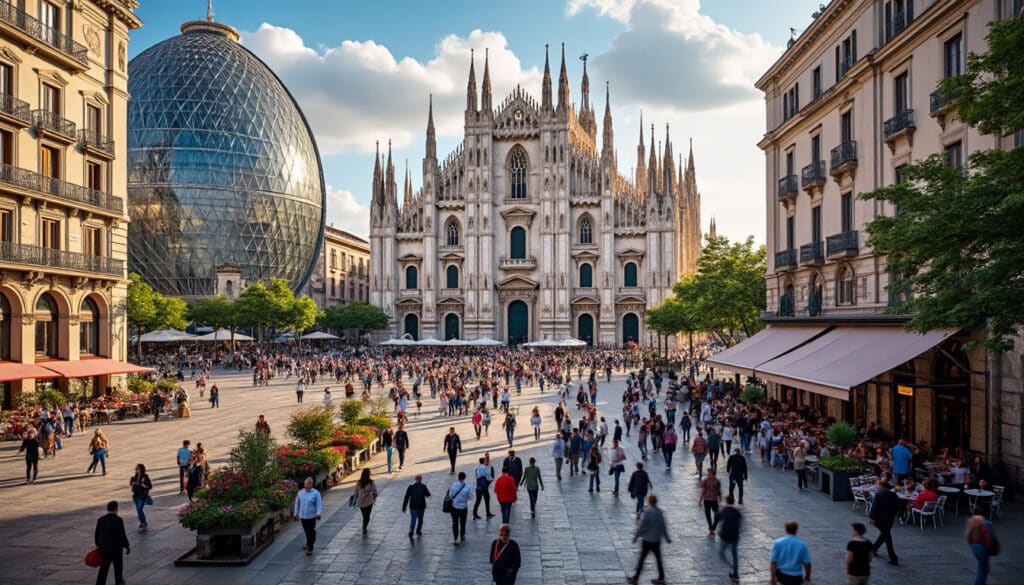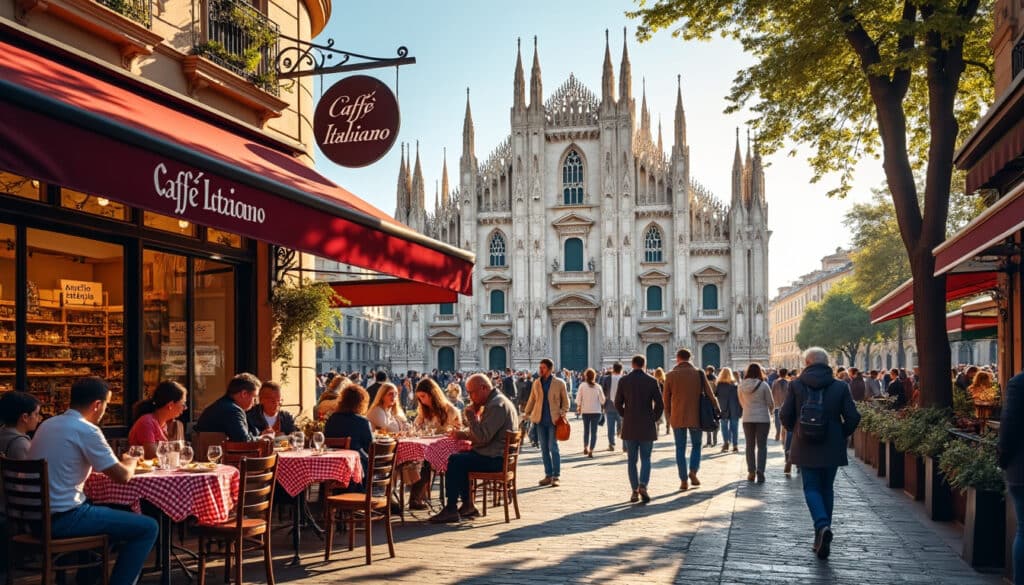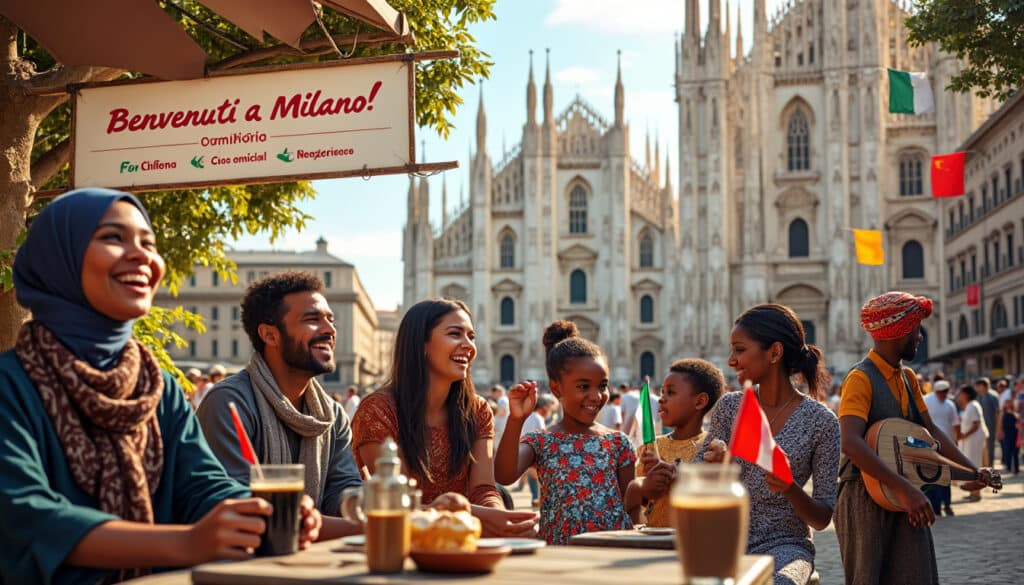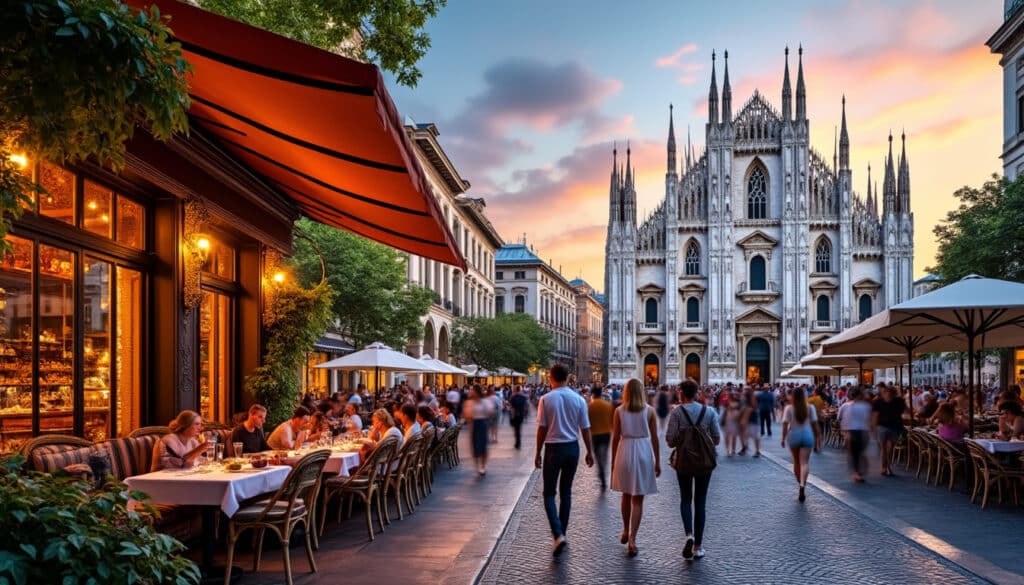Milan, in the heart of Northern Italy, has a history as rich and dynamic as its reputation as a global center for fashion and design. From its ancient beginnings to its renaissance glory, Milan has been a pivotal player in European history. This city, often overshadowed by its Italian cousin Rome, offers a compelling narrative of economic, cultural, and political prowess.
Celtic and Roman Roots of Milan
The founding of Milan dates back to around 590 BC when a Celtic tribe known as the Insubres established a settlement called Medhelanon. This name reveals the geographic significance of its location — a central place amidst the plain, as inferred from the Celtic words medhe meaning “middle” and lanon relating to “plain.” The early settlement was strategically positioned near vital watercourses including the Olona, Lambro, and Seveso rivers, adding to its appeal as a hub for trade and communication.
In 222 BC, the Romans recognized the strategic importance of Mediolanum (the Roman name for Milan) and conquered the territory. The integration into the Roman Empire elevated Milan’s status significantly, leading to its establishment as a major settlement within the province of Cisalpine Gaul. Under Roman influence, Mediolanum developed into an architectural and cultural marvel. It became well-equipped with sophisticated civic amenities, including a theater and an amphitheater, which was among the largest in Roman Italy, signaling its growing importance.
- 🌉 Strategic location for trade
- 🚀 Roman architectural advancements
- 💧 Watercourses enhancing connectivity
The Roman influence was pivotal, yet by 286 AD, under Emperor Diocletian, Milan rose to greater prominence as it became the capital of the Western Roman Empire. This decision underscored the city’s significance not only in terms of strategic location but also as a central hub of power and governance during the late Roman Empire.
| Year | Event | Significance |
|---|---|---|
| 590 BC | Foundation by the Insubres | Establishment of Medhelanon |
| 222 BC | Roman Conquest | Beginning of Roman Era |
| 286 AD | Capital of Western Roman Empire | Increased political significance |

Milan’s Transformation During the Roman Empire
As the capital, Milan was fortified with new walls, dating back to Maximian’s era, marking a transformation in its infrastructure and strategic prowess. The city became a focal point for the arts and culture, contributing immensely to the Roman silver and ivory industries.
The Roman period was not just a phase of structural development but also of religious transformation — from pagan roots to the spread of Christianity, highlighted by notable figures like Saint Ambrose. It was during this tumultuous yet fruitful period that the Edict of Milan was issued in 313 AD by Emperor Constantine, granting religious tolerance throughout the empire and paving the way for the swift spread of Christianity.
- 🏛️ Transformation into a capital city
- 🗺️ Architectural advancements
- ⛪ Spread of Christianity
Mediolanum, with its combination of military, political, and religious significance, became an exemplary model of Roman adaptability and legacy. Over centuries, these layers of history were built upon, leading to achievements in governance, culture, and economy that would later define Renaissance Milan.
The Renaissance Awakening of Milan
The decline of the Roman Empire paved the way for Milan’s renaissance during the late medieval period into the early modern age. The city was a significant stage for geopolitical struggles, transitioning between rulers such as the Visconti and Sforza families. This era was crucial for Milan, serving as the crucible where its artistic and cultural legacy truly flourished.
Under the Sforza rule, Milan became a center of renaissance art and intellect, drawing prominent figures such as Leonardo da Vinci to its courts. Da Vinci’s works, including his famous mural “The Last Supper,” are emblematic of the city’s golden era of art patronage, creating a lasting cultural legacy. The cityscape transformed with ambitious projects like the Duomo di Milano, breaking grounds in Gothic architecture and cementing Milan’s status as a renaissance powerhouse.
- 🖼️ Flourishing arts under Sforza rule
- 🎨 Da Vinci’s iconic contributions
- 🏰 Architectural marvels
This period also witnessed Milan’s expansion as a vital economic center. The Sforzas invested in silk and wool, foundation stones of its textile industry, which would burgeon in the centuries to come. These industries laid the groundwork for contemporary Milan, known globally today for fashion houses like Prada, Gucci, Versace, and Dolce & Gabbana, ensuring Milan lived up to its reputation as a fashion capital.
| Name | Contribution | Legacy |
|---|---|---|
| Leonardo da Vinci | “The Last Supper” | Iconic Renaissance Art |
| Sforza Family | Economic and Cultural Patronage | Foundation of Milan’s Renaissance |
| Main Cathedral | Duomo di Milano | Architectural Innovation |
Architectural Renaissance
The Duomo, a stunning exemplar of Gothic architecture, began construction in 1386 under Archbishop Antonio da Saluzzo, supported by the people of Milan. It symbolized the city’s collective aspiration and was emblematic of the era’s artistic ambition. Amidst Milan’s renaissance, the delicate sculptures and intricate design of the Duomo became a center of spiritual and social life.
The period also saw the crafting of the Castello Sforzesco, a fortress turned ducal palace that today holds captivating art collections. Milan’s ambition was supported by commissions that fortified its status as a hub of creativity and artistry across Renaissance Europe.
Milan Under Foreign Dominations
Milan’s strategic and economic significance made it a coveted prize for European powers, leading to a series of foreign dominations. Following the end of the Sforza line, Milan came under Spanish control in the 16th and 17th centuries. The Spanish rulers brought enhancements to the city’s infrastructure but tightened control, leading to economic and social strains.
The economy, while somewhat stable due to its critical role in Spain’s military logistics, suffered from oppressive taxation. However, cultural pursuits didn’t entirely wane; Milan’s longing for artistic expressions found ways through music and opera thriving in this period, subtly undermining the stringent controls.
- ⚔️ Strategic military importance
- 💰 Economic fluctuations
- 🎭 Opera and musical evolution
The 18th century ushered in Austrian rule following the War of Spanish Succession. This era was marked by liberal reforms, fostering economic recovery and enlightenment ideals. The Austrians promoted Milan’s cultural sectors, establishing educational institutions and paving the way for modern urban planning.
| Period | Dominating Power | Key Contributions |
|---|---|---|
| 16th – 17th century | Spanish Control | Military logistics, Opera |
| 18th century | Austrian Rule | Education and Enlightenment |
By the time Napoleon swept across Europe, Milan had consolidated a reputation for cultural resilience, underpinning its role in political upheavals and the eventual unification of Italy.
The Industrial and Modern Era
The 19th and 20th centuries marked profound transformations for Milan. Post the Napoleonic wars, Milan became a center of Italian nationalism and the unification movement, also known as the Risorgimento. Milan’s strategic positioning and industrial capacity played pivotal roles in shaping Italy’s modern state.
The city emerged as the economic heart of Italy, prompting an explosive growth during the industrial revolution. Industries thrived, with notable enterprises such as Pirelli, Fiat, Alfa Romeo, and Bulgari establishing their operations, cementing Milan’s status as a leading industrial and financial center. Indeed, Milan transformed into a metropolis characterized by vibrant urban life, cultural dynamism, and industrial innovation.
- 🏙️ Emergence as Italy’s economic hub
- 🚗 Birth of renowned industries
- 🌆 Urban and cultural transformation
The 20th century was equally transformative, with Milan navigating through world wars, economic booms, and political upheavals. It became the stage for pivotal movements such as Fascism and, later, the vibrant economic revival post-World War II, often referred to as the “Italian economic miracle.” The modernization efforts saw the development of advanced infrastructure, paving the way for Milan to become a global innovation leader.
| Century | Development | Significance |
|---|---|---|
| 19th | Industrial Development | Economic Leadership |
| 20th | Reconstruction & Innovation | Global City Status |
Milan: A Global Fashion Capital
Today, the legacy of Milan is indelibly linked with fashion. The city’s spirited embrace of modernity saw the rise of its fashion industry, becoming synonymous with high fashion and luxury. Milan’s fashion week draws designers, celebrities, and industry leaders from around the globe, with iconic fashion houses like Armani, Versace, and Gucci having their roots here.
Against the backdrop of a rich historical tapestry, contemporary Milan thrives on creativity, innovation, and cosmopolitan lifestyle, continuing to shape its legacy within the framework of tradition and modern aspirations.
FAQ
Q: When is the Milan Fashion Week held?
A: Milan Fashion Week is typically held twice a year, showcasing spring/summer collections in February-March and autumn/winter collections in September-October.
Q: What makes Milan’s Renaissance period significant?
A: The Renaissance marked a golden age for Milan, with immense contributions in art, urban development, and cultural dynamics, including the work of Leonardo da Vinci.
Q: How did Milan become a hub for global fashion brands?
A: Milan’s transformation into a fashion hub is due to its history of textile production, cultural patronage, and the establishment of influential fashion houses such as Prada and Dolce & Gabbana.
Q: What are some iconic places to visit in Milan?
A: Must-visit places include the Duomo di Milano, Castello Sforzesco, La Scala opera house, and the vibrant districts like Brera and Navigli.
Q: How has Milan’s industrial past shaped its present?
A: Milan’s industrialization established it as an economic powerhouse, leading to its contemporary status as a cultural and financial epicenter in Italy and Europe.

Fun Facts & Curiosities About Milan
Milan, often recognized as a global beacon of style, combines its fashion-forward reputation with a deep-rooted cultural and historical tapestry. From its majestic Gothic cathedral to the vibrant hustle of Milan Fashion Week, the city is aflame with stories waiting…

Architecture and urban features of Milan
Milan, a pulsating metropolis, is celebrated not only for its unparalleled fashion sense but also for its striking architectural tapestry that paints a vivid picture of its historical evolvement and modern aspirations. Known as Italy’s design Mecca, the city offers…

Milan, a city synonymous with fashion, luxury, and culture, stands as a beacon of Italian sophistication. Nestled in the heart of Lombardia, this city is not just about runways and designer labels. Daily life in Milan merges contemporary flair with…

Demographics and geography of Milan
Milan, a bustling metropolis located in northern Italy, is not just renowned for its rich cultural heritage and fashion prestige but also for its demographic and geographic complexity. Home to some of the world’s most iconic brands such as Gucci,…

Holidays and celebrations in Milan
The vibrant city of Milan, known as Italy’s fashion and cultural hub, offers a delightful array of holidays and celebrations that reflect its rich history and modern allure. From the festive atmosphere of Milanese Holidays to the charm of Italian…

Language and spelling of Milan
Milan, a bustling metropolis located in northern Italy, is not only famous for its fashion and design shows, such as the renowned Milan Fashion Week and the acclaimed Milan Furniture Fair, but it also boasts a rich tapestry of languages…

Local tips for tourists in Milan
Milan, often celebrated as the financial and fashion heartbeat of Italy, beckons travelers with its blend of historic intrigue and contemporary flair. As the sun rises over the city’s rooftops, it casts a golden glow on architectural icons like the…

Names, flags, and identity of Milan
Milan, a city renowned for its significant economic influence, captivating cultural history, and pioneering fashion industry, is replete with rich symbols and emblems that define its identity. From its origins as Mediolanum to its modern reputation as a global fashion…

Reputation and identity of Milan
📍 Milan, the beating heart of fashion and design, has long been celebrated for its unique blend of history, culture, and modernity. As a global hub of innovation, it seamlessly marries its ancient past with its cutting-edge present, creating a…

Milan, a buzzing epicenter of fashion, culture, and history, holds a unique position in the globe not only for its iconic landmarks and vogue narratives but also for its specific place within the world’s time zones. When planning a trip…

Unusual facts and social issues in Milan
Milan, a bustling metropolis in the heart of Italy, is renowned for its chic fashion scene, rich historical tapestry, and unique cultural quirks. From Leonardo da Vinci’s incredible legacy to the iconic Milan Fashion Week, the city offers an array…

What does Milan look, smell, feel like?
Milan, a city of irresistible charm, stands on the cusp of modernity and tradition, casting a spell on anyone who dares to wander through its captivating streets. Known globally as the fashion capital, Milan is much more than its runways.…


